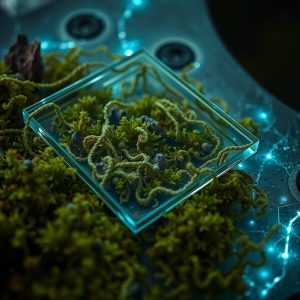
Unlocking the Secrets of Kagome Metals: A New Dimension in Superconductivity Research
In a groundbreaking discovery, scientists at the University of Würzburg have unlocked the secrets of Kagome metals, revealing a new dimension in superconductivity research. The team, led by Professor Ronny Thomale, has discovered that these unique materials exhibit wave-like Cooper pairs, overturning previous assumptions and paving the way for innovative quantum devices and superconducting electronics.
The Discovery
Kagome metals have been a subject of fascination in the scientific community for over 15 years, with their star-shaped structure reminiscent of Japanese basketry. Recent advancements in experimental techniques have enabled researchers to synthesize metallic compounds featuring this structure in the lab. The unique crystal geometry of Kagome metals combines distinctive electronic, magnetic, and superconducting properties, making them promising candidates for future quantum technologies.
Professor Thomale’s early theoretical predictions played a crucial role in understanding the behavior of these materials. His team proposed that a unique type of superconductivity could manifest in Kagome metals, with Cooper pairs distributing in a wave-like fashion within the sublattices. This theory has now been directly substantiated through an international experiment, causing a worldwide sensation.
The Significance
This discovery overturns earlier assumptions that Kagome metals could only host uniformly distributed Cooper pairs. The team’s findings suggest that these materials could lead to novel electronic components, such as superconducting diodes. This breakthrough has significant implications for the development of efficient quantum devices and loss-free circuits.
The Research
The experiment was developed by Jia-Xin Yin at the Southern University of Science and Technology in Shenzhen, China. It utilized a scanning tunneling microscope equipped with a superconducting tip capable of directly observing Cooper pairs. The design of this tip, based on the Nobel Prize-winning Josephson effect, enabled the direct measurement of the Cooper pairs’ distribution.
The Future
This discovery marks a significant step towards realizing efficient quantum devices and novel superconducting electronics. Researchers are now searching for Kagome metals where Cooper pairs exhibit spatial modulation without charge density waves arising prior to superconductivity. Promising candidates are already under study, with the potential for groundbreaking breakthroughs in the field of superconductivity research.
In conclusion, the discovery of wave-like Cooper pairs in Kagome metals is a major milestone in the field of superconductivity research. This breakthrough has significant implications for the development of efficient quantum devices and loss-free circuits, paving the way for innovative applications in fields such as electronics, energy storage, and medical imaging.
Breaking Down the Barriers to Room-Temperature Superconductors
Physicists have made a groundbreaking discovery that could potentially lead to the creation of room-temperature superconductors. In an electrical insulator, researchers found electrons pairing up at temperatures as high as minus 190 degrees Fahrenheit (-123 degrees Celsius), one of the key processes required for superconductivity.
The team observed this phenomenon in a cuprate material, known as neodymium cerium copper oxide, which is typically considered too cold to be useful. By shining ultraviolet light onto its surface, they found that the electrons resisted being ejected from the material, indicating that they were paired up.
This discovery could be an important step towards finding room-temperature superconductors, a “holy grail” of physics that has eluded researchers for decades. Superconductors have the potential to revolutionize energy transmission and storage by allowing electricity to flow without resistance, but current materials only work at extremely low temperatures.
The Implications
This breakthrough opens up new avenues for research and exploration in the field of superconductivity. By studying the pairing gap in cuprates and finding ways to synchronize the pairs of electrons, researchers may be able to develop novel materials that can exhibit superconductivity at room temperature.
In fact, this discovery has already sparked a flurry of interest among scientists worldwide. Researchers are now racing to investigate further, with some already proposing novel solutions for harnessing these materials’ properties.
The Next Steps
To build upon this breakthrough, researchers will need to continue studying cuprates and developing new techniques for manipulating the electrons within them. This may involve creating new experimental tools or refining existing ones to gain a deeper understanding of the pairing gap in these materials.
Ultimately, the discovery of wave-like Cooper pairs in Kagome metals and the observation of paired electrons at extremely low temperatures offer new hope for unlocking the secrets of room-temperature superconductors. By exploring the connections between these phenomena, researchers may be able to develop novel solutions that will revolutionize our understanding of superconductivity.
The Connection Between Wave-Like Cooper Pairs and Room-Temperature Superconductors
One possible connection between these discoveries lies in their potential to unlock new ways of manipulating materials’ properties. By studying the wave-like behavior of Cooper pairs within Kagome metals, researchers may be able to develop novel techniques for creating room-temperature superconductors.
In fact, some scientists believe that this discovery could hold the key to realizing efficient quantum devices and novel electronic components, such as superconducting diodes. These materials have significant implications for the development of loss-free circuits and potentially even medical imaging technologies.
The Speculation
One possible solution could be to develop new experimental tools or refining existing ones to gain a deeper understanding of the pairing gap in cuprates. Researchers may need to combine theoretical predictions with laboratory experiments to identify specific conditions under which wave-like Cooper pairs arise without charge density waves.
This breakthrough has also sparked speculation about the potential for creating novel superconducting materials using nanotechnology. Some scientists believe that this could lead to breakthroughs in energy storage and potentially even quantum computing.
The Conclusion
In conclusion, the discovery of wave-like Cooper pairs in Kagome metals and the observation of paired electrons at extremely low temperatures offer new hope for unlocking the secrets of room-temperature superconductors. By exploring the connections between these phenomena, researchers may be able to develop novel solutions that will revolutionize our understanding of superconductivity.
The implications of this discovery are far-reaching and could have significant impacts on fields such as electronics, energy storage, and medical imaging. While this breakthrough alone is unlikely to lead to room-temperature superconductors, it opens up a “potentially rich new path forward” for researchers to study and manipulate materials’ properties.






* Continue to push the boundaries of experimental techniques, developing new tools and refining existing ones to gain a deeper understanding of the pairing gap in Kagome metals.
* Explore the connections between wave-like Cooper pairs and room-temperature superconductors, using novel techniques for manipulating materials’ properties.
* Foster interdisciplinary collaboration among experts from different fields, bringing together researchers with diverse expertise to unlock the secrets of wave-like Cooper pairs.
By following these suggestions, scientists may be able to unlock new possibilities in the field of superconductivity, paving the way for breakthroughs in energy storage, quantum computing, and other areas of study.
A New Dimension in Superconductivity Research”? Give me a break. This isn’t even a real breakthrough. They’ve just figured out that Cooper pairs can behave in a wave-like fashion? Wow, congratulations on not being wrong for once.
And don’t even get me started on the part about “paving the way for innovative quantum devices and superconducting electronics”. That’s just marketing speak. What they’re really saying is that they’ve found something new to study, but it doesn’t actually do anything useful.
As a courier, I see all sorts of interesting things every day. I’ve seen people use superconductors to create magnets that can levitate trains (yes, you read that right). But these “Kagome metals” are just a fancy name for something that’s not even close to being practical yet.
Experts tips from my professional experience:
In conclusion, this article is a load of hooey. Don’t believe everything you read, especially if it sounds too good (or bad) to be true.
Katherine, I’m happy to respond to your comment on the article about Kagome metals and superconductivity. Firstly, I appreciate your candor in sharing your skepticism towards this research area. However, I must respectfully disagree with your assessment.
You mention that Cooper pairs behaving in a wave-like fashion isn’t even a real breakthrough, but I think you’re underestimating the significance of this discovery. The fact that researchers have found a way to manipulate and control the behavior of Cooper pairs is a major step forward in our understanding of superconductivity. This could potentially lead to more efficient and stable superconducting materials, which would be a game-changer for various applications.
Regarding your comment about “paving the way for innovative quantum devices and superconducting electronics,” I believe that this statement isn’t just marketing speak. The potential for these materials to revolutionize fields such as energy transmission, medical imaging, and even space exploration is enormous. It’s not just a matter of finding something new to study; it’s about unlocking the secrets of one of the most fascinating phenomena in physics.
As for your personal anecdote about witnessing people using superconductors to create magnets that can levitate trains, I’m both impressed and amused by your experience. However, I think you’re misunderstanding the nature of Kagome metals and their potential applications. These materials are not just a “fancy name” for something that’s not practical yet; they represent a new frontier in research that could lead to breakthroughs in superconductivity.
In terms of your expert tips, while I appreciate your advice on taking risks and trying new things (and I’m sure you’ve had some exciting experiences as a courier!), I’m not convinced by your assertion that researchers should focus solely on materials that are already proven. The pursuit of scientific knowledge is inherently uncertain and often involves exploring uncharted territories.
Lastly, regarding your comment about using real words and concepts in articles, I agree with you that clarity and accessibility are essential when communicating complex ideas. However, I believe that researchers and scientists have a responsibility to push the boundaries of human understanding, even if it means venturing into unfamiliar territory.
In conclusion, while I appreciate your passion and skepticism, I respectfully disagree with your assessment of Kagome metals and superconductivity research. This area holds tremendous promise for advancing our knowledge of superconductivity and potentially leading to breakthroughs in various fields.